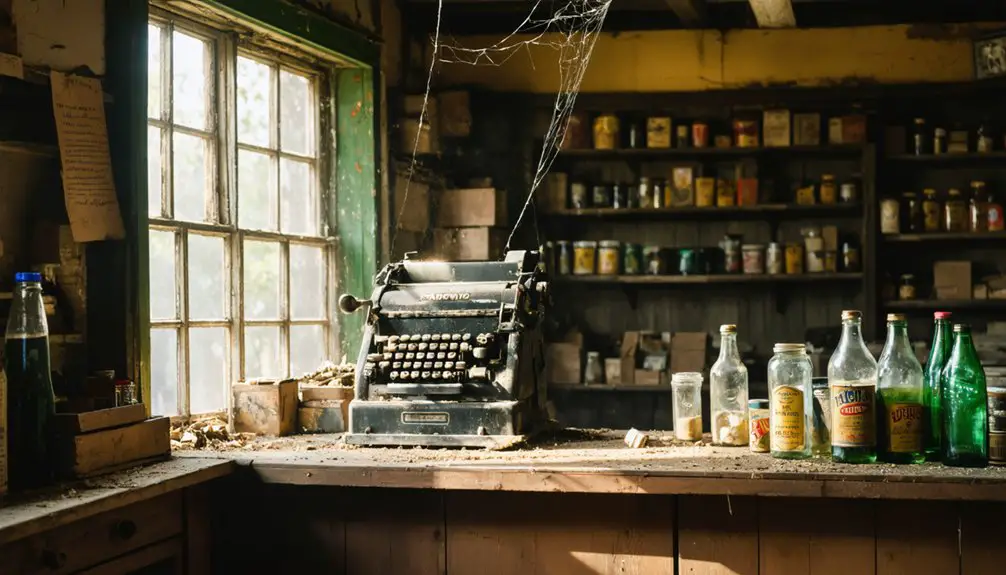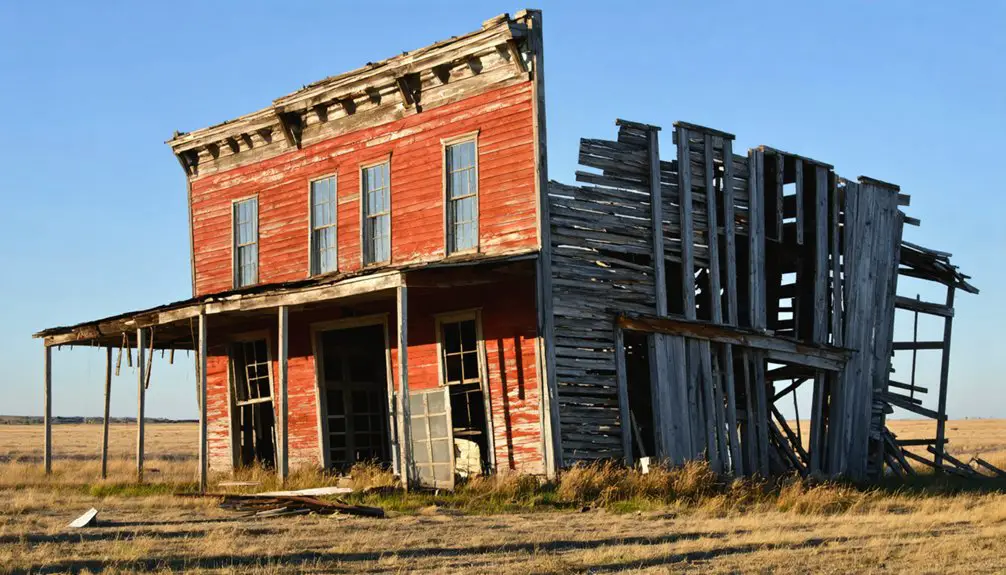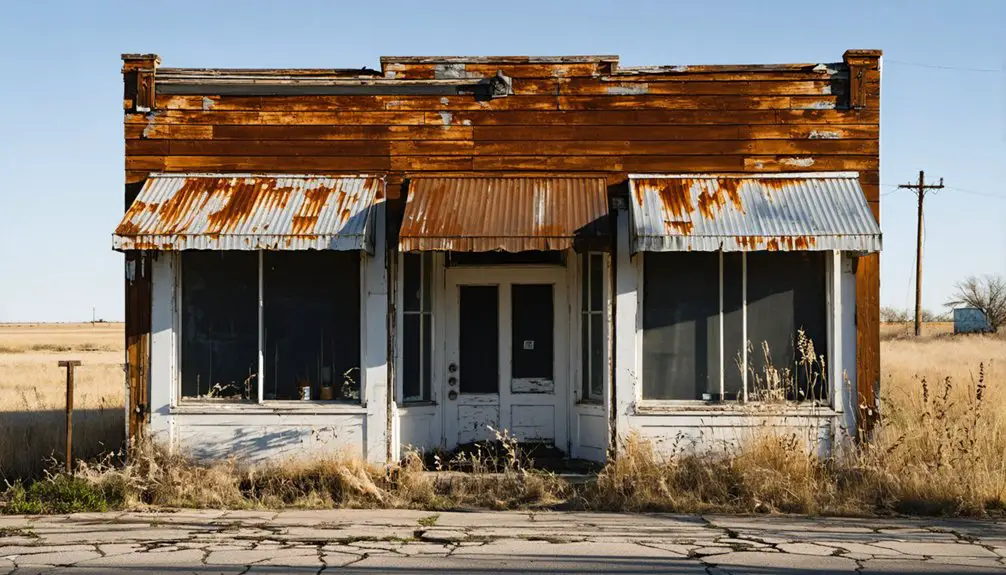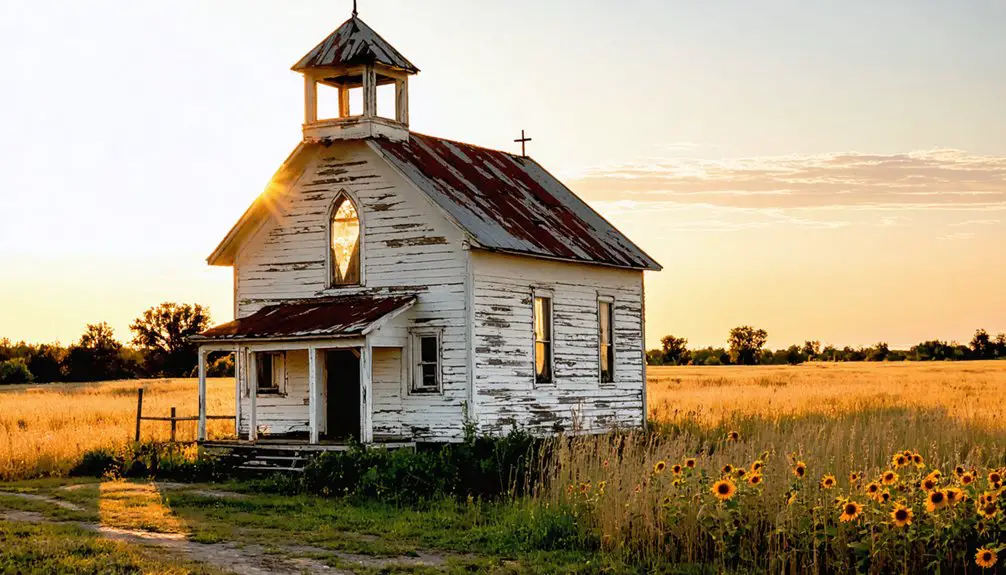You’ll find Bernice, Oklahoma’s ghostly remains beneath Grand Lake’s waters and along its shores. Founded in 1912 as a railroad boomtown, it grew to 400 residents by 1918 with thriving banks, stores, and a bustling train station serving 25-30 daily routes. The construction of Pensacola Dam in 1941 submerged the original townsite under 20 feet of water, though you can still discover historical markers, early 20th-century buildings, and local cemeteries that tell its fascinating story.
Key Takeaways
- Bernice’s original townsite was submerged under 20 feet of water after the construction of Pensacola Dam in 1941.
- The town’s population dramatically declined from 400 residents in 1918 to just 91 by 1940.
- Underwater remnants include railroad tracks and building foundations from the original settlement.
- Historical markers along Grand Lake’s shoreline commemorate the town’s location and history.
- Early 20th-century buildings and homes remain on higher ground, along with cemeteries containing original settler graves.
From Needmore to Bernice: A Town’s Beginning
While the small community of Needmore had served local residents for years, the establishment of Bernice in 1912 marked a significant shift in Delaware County’s development.
You’ll find the story began when Rose Mode and Charles Lee purchased 60 acres in the Horse Creek Basin, naming their new town after Mode’s daughter Bernice.
The strategic town migration from Needmore to Bernice reflected changing economic patterns, as businesses sought better opportunities near the railroad crossing.
The railroad’s promise of prosperity drew businesses away from Needmore, as they relocated to capitalize on Bernice’s strategic rail connection.
To ensure accurate historical navigation, researchers frequently encounter multiple disambiguation page references when studying Bernice’s past.
The new community identity took shape around this prime location, with Bernice’s higher ground and rail access proving more attractive than Needmore’s site two miles east.
Within a year, Bernice had its own post office, and by 1918, nearly 400 residents called it home.
Today, Bernice remains one of Delaware County’s incorporated towns, maintaining its historical significance in the region.
Native American Heritage and Early Settlement
Before Bernice emerged as a railroad town, the rich lands of northeastern Oklahoma belonged to several indigenous peoples, most importantly the Osage and various Woodland tribes.
The region’s cultural resilience became evident through the challenging years following the Indian Removal Act of 1830, when the Five Civilized Tribes were forcibly relocated to the territory.
You’ll find traces of tribal governance in the area’s history, particularly through the Cherokee and Delaware settlements that emerged near present-day Bernice. The Lower Creek Indians established their home in the broader region in 1833, naming their settlement Tallasi.
Historical alliances formed between tribes as they adapted to shared territories, though not without tension. The Bureau of Indian Affairs established agencies throughout the territory to manage relationships between tribes and the federal government.
The indigenous peoples’ sophisticated resource management techniques shaped the early landscape, influencing hunting, fishing, and agricultural practices.
Their legacy lives on through place names, oral histories, and sacred sites that dot the northeastern Oklahoma countryside.
The Railroad Era and Economic Growth
You’ll find that Bernice’s transformation into a thriving commercial center began when the Missouri, Kansas and Texas Railroad established a station there in the early 1900s.
The railroad’s presence attracted merchants, hoteliers, and entrepreneurs who quickly established businesses along the train route to serve both travelers and local residents. Passenger service became essential to the town’s growth as railways like Frisco operated 25-30 trains daily through the region.
During the Dust Bowl crisis of the 1930s that devastated much of the state’s agricultural communities, many families in Bernice were forced to relocate.
As similar to other Oklahoma railroad towns like Afton, Bernice’s strategic location along the rail line helped it develop into a bustling trade hub with essential services and infrastructure supporting the surrounding agricultural community.
Railroad Station Development
The establishment of Bernice’s railroad station in 1912 marked a pivotal moment in the town’s development, serving as the catalyst for its initial growth and commercial importance.
The Kansas, Oklahoma, and Gulf Railroad constructed these vital transportation links through Delaware County, transforming the landscape.
You’ll find that the railroad impact transformed Bernice from an open crossing near Horse Creek into a bustling hub of activity, with the station architecture anchoring the town’s expanding commercial district.
Similar to the Frisco Railway operations in nearby regions, the station facilitated significant freight exchanges that boosted local commerce.
As businesses relocated from nearby Needmore to be closer to the rail line, you’d have seen the station area become the heart of local commerce.
The strategic placement of Bernice’s railroad facilities wasn’t just about transportation – it created a focal point for community growth, where merchants, farmers, and ranchers could connect to broader markets.
This rail connectivity proved essential for the town’s integration into the regional economy.
Commerce Along Train Routes
Building on the railroad station’s presence, commerce in Bernice flourished through a network of small country stores and agricultural enterprises that emerged in the late 1880s.
You’d find merchants leveraging train commerce to attract customers from surrounding areas, promoting their sales widely before the town experienced flooding.
The railroad’s presence transformed Bernice beyond basic subsistence farming, enabling ranchers and commercial farmers to expand their operations through enhanced economic exchange.
The development mirrored nearby Miami Tribe settlements that established successful trading posts along rail corridors.
You could see this growth reflected in the development of essential businesses – hotels, banks, creameries, mills, and grain elevators – all thriving due to the constant flow of goods and people along the train routes.
When the Kansas, Oklahoma and Gulf railroad arrived in 1913, the town officially changed its name from Needmore to Bernice, marking a new era of economic development.
Life in Early 20th Century Bernice
During Bernice’s formative years in the early 1900s, life centered around agricultural pursuits and railroad commerce, with the town’s population reaching nearly 400 residents by 1918.
You’d find a bustling community where social dynamics revolved around essential businesses like the local bank, sawmill, grain elevator, and hotel.
Agricultural practices evolved from basic subsistence farming to more specialized operations, with dairy and egg production showing remarkable growth through the 1920s.
The post office’s establishment in 1913 marked a pivotal point in the town’s development, while the railroad enabled farmers to ship their goods efficiently.
You could’ve witnessed the shift from labor-intensive row crops to cattle ranching, as residents adapted to changing market demands and new opportunities in the agricultural sector.
Key Businesses and Community Development

You’ll find that Bernice’s early commercial growth centered around its railroad station, which facilitated trade and transport for the agricultural community.
The town’s initial business presence emerged from a small country store operating under the name Needmore in the late 1880s, setting the foundation for future development.
Railroad Station Operations
When the Kansas, Oklahoma and Gulf Railroad established its Bernice station in 1912-13, the operation transformed this small Delaware County settlement into an essential transportation hub.
You’d find the station bustling with freight services handling agricultural products, livestock, and timber bound for distant markets in Kansas and Texas. The strategic location included a wye track that let trains turn around and connect to important spur lines.
Regular railroad schedules kept Bernice connected to the wider world, while the station’s infrastructure, including the impressive Horse Creek Bridge, helped anchor the town’s position in regional commerce.
After serving the community for 50 years, the KO&G ceased operations in 1962, and the old rail bed found new life as State Highway 85A.
Early Commercial Establishments
By 1918, five key commercial sectors defined Bernice’s thriving business district: banking, agricultural processing, timber milling, retail trade, and hospitality services.
Early banking established a critical foundation for local commerce, enabling farmers and entrepreneurs to access credit and secure their earnings.
You’d have found a bustling agricultural economy centered around the grain elevator and flour mill, while the sawmill supplied lumber for the region’s expanding development.
Three general stores anchored the retail landscape, providing essential goods and creating natural gathering spots for the community of 400 residents.
The town’s hotel served traveling merchants and visitors, solidifying Bernice’s position as a significant commercial hub in the area.
Factors Leading to the Town’s Decline
Although Bernice, Oklahoma initially thrived after the Kansas, Oklahoma and Gulf Railroad’s arrival in 1913, several interconnected factors led to the town’s eventual decline and transformation into a ghost town.
The population decline began after World War I, dropping from 400 residents in 1918 to just 91 by 1940. Economic shifts, including the Great Depression, weakened the local business base and accelerated out-migration.
- Construction of Pensacola Dam in 1941 forced final evacuation of the original townsite
- The town’s location in the flood-prone Grand River valley sealed its fate
- Formation of Grand Lake submerged the old town under 20 feet of water
- Commercial activity ceased as merchants liquidated their stock
- Social institutions, including churches and schools, were dismantled or destroyed
Remnants and Historic Sites Today

While most of Bernice’s original townsite lies submerged beneath Grand Lake’s waters, scattered remnants of this once-thriving community still exist both above and below the surface.
You’ll find submerged artifacts like railroad tracks and building foundations visible through the lake’s depths, while historical markers dot the shoreline. Early 20th-century homes and weathered commercial buildings stand on higher ground, offering glimpses into the town’s past.
Local cemeteries preserve the stories of original settlers through well-maintained headstones and memorial plaques. You can explore nearby museums featuring exhibits of recovered artifacts and photographs, or visit interpretive centers that detail the impact of the Grand Lake dam project.
Today’s Bernice balances its ghost town heritage with modern tourism, as fishing spots and boat launches provide access to both historical sites and recreational activities.
Preserving Bernice’s Legacy
The legacy of Bernice endures through dedicated preservation efforts that span multiple dimensions of community action.
You’ll find community activism at the heart of protecting this historic site, where local grassroots groups lead preservation strategies through volunteerism and public awareness campaigns.
Digital documentation and partnerships between state agencies and historical societies guarantee that Bernice’s story won’t be lost to time.
- Local groups collaborate with the Oklahoma Historical Society to preserve artifacts and records
- Environmental remediation projects protect the physical landscape for future generations
- Digital archiving initiatives make historical documents and photographs publicly accessible
- Community volunteers conduct regular documentation of remaining structures and sites
- Educational outreach programs share Bernice’s cultural significance with new audiences
Lessons From a Lost Oklahoma Community

Studying Bernice’s transformation from a thriving agricultural community to an underwater ghost town reveals crucial lessons about the human cost of infrastructure development.
You’ll find that when Pensacola Dam’s waters rose in 1941, they didn’t just submerge buildings – they disrupted generations of community bonds and economic networks. The town’s story demonstrates how large-scale projects can dramatically alter rural America’s landscape and social fabric.
Yet Bernice’s experience also shows remarkable community resilience. While the original settlement lies 20 feet underwater, residents adapted by rebuilding on higher ground.
The environmental impact transformed local agriculture into a recreation-based economy, with the area now known for its fishing and lakeside attractions.
You’re witnessing a stark example of how communities must sometimes reinvent themselves when faced with unstoppable change.
Frequently Asked Questions
What Was the Peak Population of Bernice During Its Most Prosperous Years?
While you might expect higher numbers during railroad prosperity, Bernice’s peak population reached just over 200 residents in 1940, before economic factors and population decline led to the town’s submersion under Grand Lake.
Are There Any Annual Events or Gatherings Held at the Ghost Town?
You won’t find any ghost town festivals or paranormal tours at this site today. The location doesn’t host organized annual events or gatherings, remaining a quiet historical landmark without scheduled activities.
Can Visitors Legally Explore the Remaining Structures in Bernice Today?
You can’t legally explore Bernice’s original structures since they’re submerged under 20 feet of water. There aren’t any exploration guidelines or legal permissions established for accessing these underwater ruins.
What Happened to the Original Railroad Tracks That Ran Through Bernice?
You won’t find any original railroad history preserved here – the tracks were removed when Grand Lake flooded the area, and the old Missouri, Oklahoma and Gulf Railway route was converted into today’s highway.
Were There Any Notable Crimes or Incidents in Bernice’s History?
You’d be surprised – beyond Miller’s fatal shooting in 1926 and a gas station’s mysterious burning in 1971, there aren’t many documented crimes, though locals whisper about unsolved mysteries along old Route 66.
References
- https://en.wikipedia.org/wiki/List_of_ghost_towns_in_Oklahoma
- https://pastmaps.com/explore/us/oklahoma/delaware-county/bernice/hiking-exploration
- https://www.youtube.com/watch?v=1X2oVx8rils
- https://www.ghosttowns.com/states/ok/bernice.html
- https://www.okhistory.org/publications/enc/entry?entry=DE010
- https://en.wikipedia.org/wiki/Bernice
- https://kids.kiddle.co/Bernice
- https://thomas.church/us-location/st-thomas-church-in-bernice-oklahoma/
- https://files.eric.ed.gov/fulltext/ED370753.pdf
- https://www.familysearch.org/en/wiki/Oklahoma_Indigenous_Peoples



